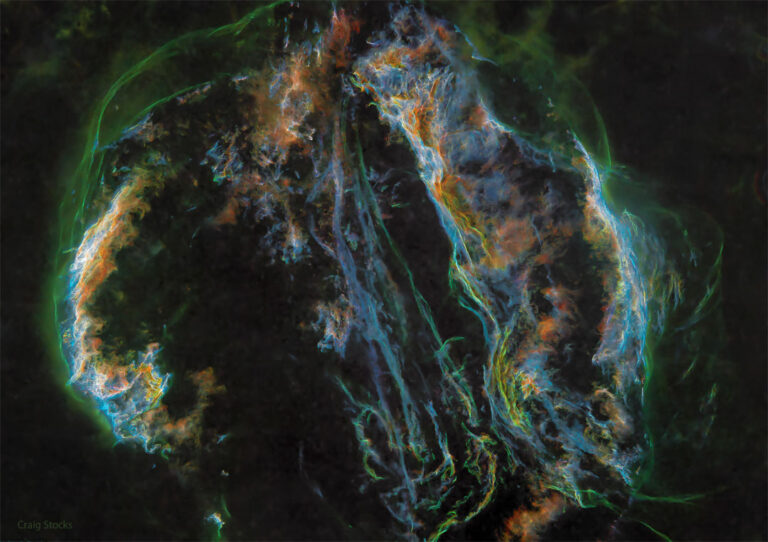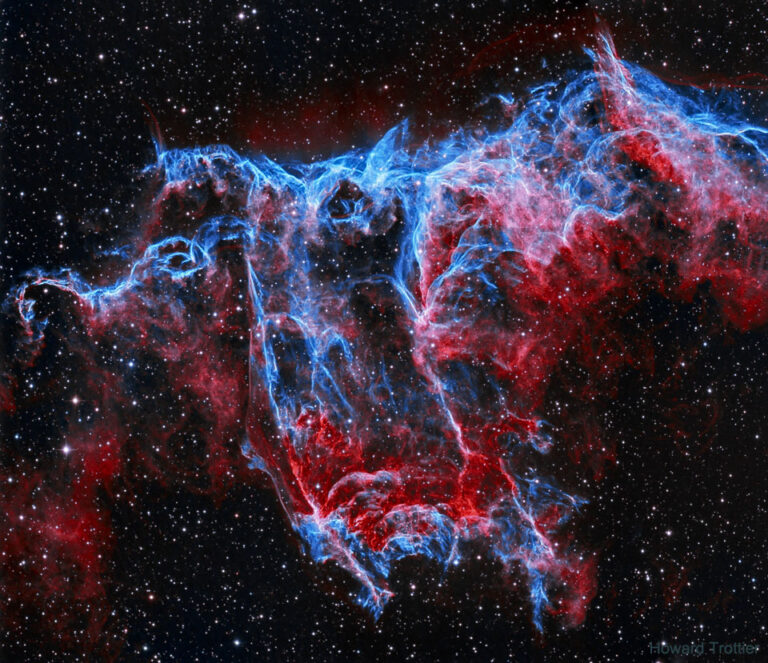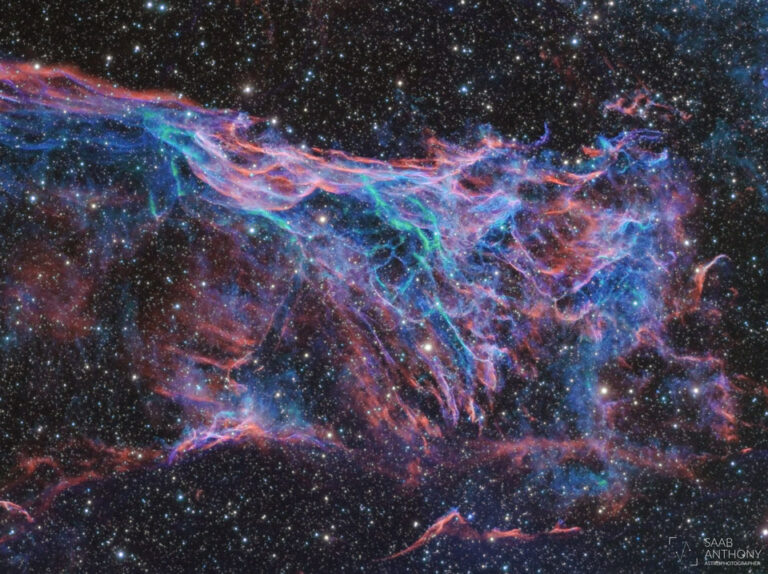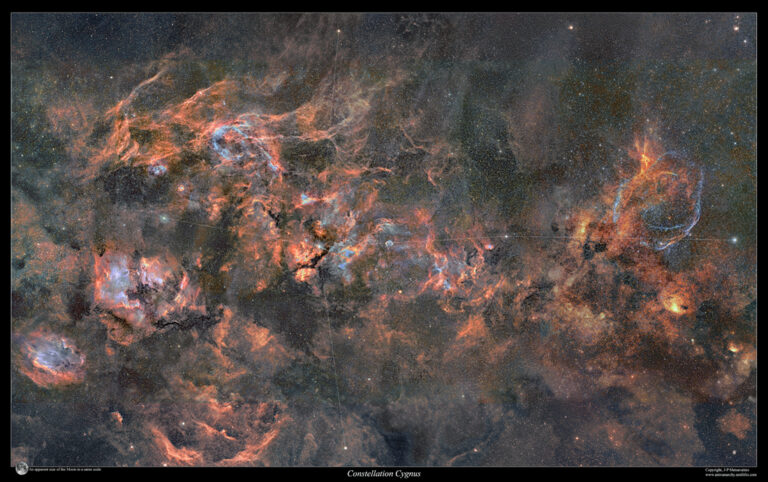NGC 6995: 蝙蝠星云
The featured image shows a starfield with a two-colored nebula in the center. The nebula is colored mostly red and blue. Please see the explanation for more detailed information.
这张特色图片显示了一个中心有一个双色星云的星场。星云的颜色主要是红色和蓝色。有关更多详细信息,请参阅说明。

The featured image shows a starfield with a two-colored nebula in the center. The nebula is colored mostly red and blue. Please see the explanation for more detailed information.
这张特色图片显示了一个中心有一个双色星云的星场。星云的颜色主要是红色和蓝色。有关更多详细信息,请参阅说明。

2023年10月18日 Dust and the Western Veil Nebula Image Credit & Copyright: Jiang Wu Explanation: It’s so big it is easy to miss. The entire Veil Nebula spans six times the diameter of the full moon, but is so dim you need binoculars to see it. The nebula was created about 15,000 years ago when a star in the constellation of the Swan (Cygnus) exploded. The spectacular explosion would have appeared brighter than even Venus for a week – but there is no known record of it. Pictured is the western edge of the still-expanding gas cloud. Notable gas filaments include the Witch’s Broom Nebula on the upper left near the bright foreground star 52 Cygni, and Fleming’s Triangular Wisp (formerly known as Pickering’s Triangle) running…

2022年6月22日 Supernova Remnant: The Veil Nebula Image Credit & Copyright: Craig Stocks (Utah Desert Remote Observatories) Explanation: Ten thousand years ago, before the dawn of recorded human history, a new light would have suddenly have appeared in the night sky and faded after a few weeks. Today we know this light was from a supernova, or exploding star, and record the expanding debris cloud as the Veil Nebula, a supernova remnant. Imaged with color filters featuring light emitted by sulfur (red), hydrogen (green), and oxygen (blue), this deep wide-angle view was processed to remove the stars and so better capture the impressive glowing filaments of the Veil. Also known as the Cygnus Loop, the Veil Nebula is roughly circular in shape and covers nearly 3…

2021年10月27日 NGC 6995: The Bat Nebula Image Credit & Copyright: Howard Trottier Explanation: Do you see the bat? It haunts this cosmic close-up of the eastern Veil Nebula. The Veil Nebula itself is a large supernova remnant, the expanding debris cloud from the death explosion of a massive star. While the Veil is roughly circular in shape and covers nearly 3 degrees on the sky toward the constellation of the Swan (Cygnus), NGC 6995, known informally as the Bat Nebula, spans only 1/2 degree, about the apparent size of the Moon. That translates to 12 light-years at the Veil’s estimated distance, a reassuring 1,400 light-years from planet Earth. In the composite of image data recorded through narrow band filters, emission from hydrogen atoms in the…

2021年7月27日 Fleming’s Triangular Wisp Image Credit & Copyright: Anthony Saab Explanation: Chaotic in appearance, these tangled filaments of shocked, glowing gas are spread across planet Earth’s sky toward the constellation of Cygnus as part of the Veil Nebula. The Veil Nebula itself is a large supernova remnant, an expanding cloud born of the death explosion of a massive star. Light from the original supernova explosion likely reached Earth over 5,000 years ago. The glowing filaments are really more like long ripples in a sheet seen almost edge on, remarkably well separated into the glow of ionized hydrogen atoms shown in blue and oxygen in red hues. Also known as the Cygnus Loop and cataloged as NGC 6979, the Veil Nebula now spans about 6 times…

2021年04月05日 Veil Nebula: Wisps of an Exploded Star Image Credit: ESA/Hubble & NASA, Z. Levay Explanation: Wisps like this are all that remain visible of a Milky Way star. About 7,000 years ago that star exploded in a supernova leaving the Veil Nebula. At the time, the expanding cloud was likely as bright as a crescent Moon, remaining visible for weeks to people living at the dawn of recorded history. Today, the resulting supernova remnant, also known as the Cygnus Loop, has faded and is now visible only through a small telescope directed toward the constellation of the Swan (Cygnus). The remaining Veil Nebula is physically huge, however, and even though it lies about 1,400 light-years distant, it covers over five times the size of…

2021年02月11日 Cygnus Mosaic 2010 – 2020 Image Credit & Copyright: J-P Metsavainio (Astro Anarchy) Explanation: In brush strokes of interstellar dust and glowing gas, this beautiful skyscape is painted across the plane of our Milky Way Galaxy near the northern end of the Great Rift and the constellation Cygnus the Swan. Composed over a decade with 400 hours of image data, the broad mosaic spans an impressive 28×18 degrees across the sky. Alpha star of Cygnus, bright, hot, supergiant Deneb lies at the left. Crowded with stars and luminous gas clouds Cygnus is also home to the dark, obscuring Northern Coal Sack Nebula and the star forming emission regions NGC 7000, the North America Nebula and IC 5070, the Pelican Nebula, just left and a…